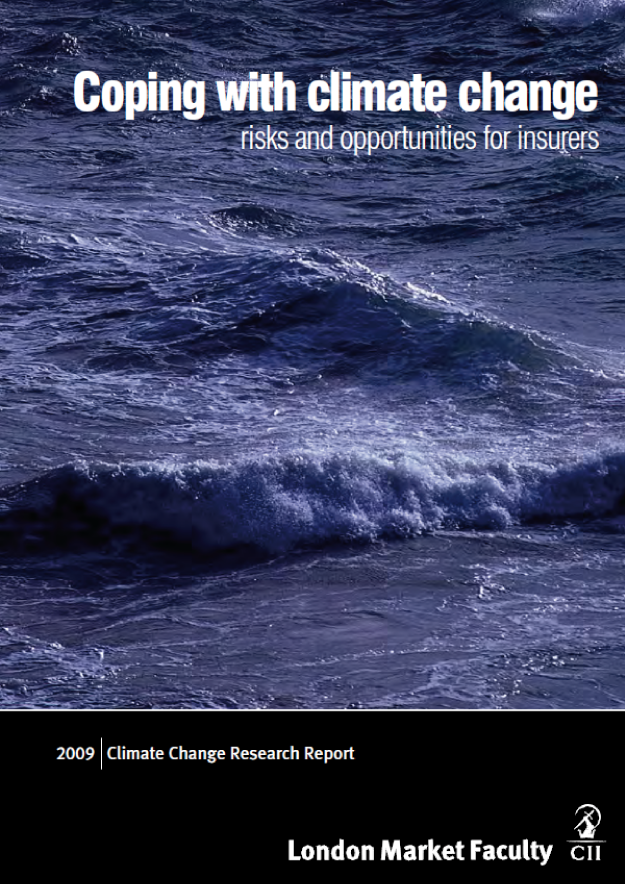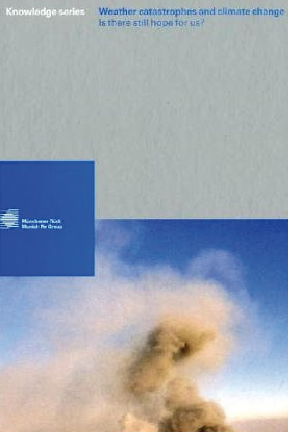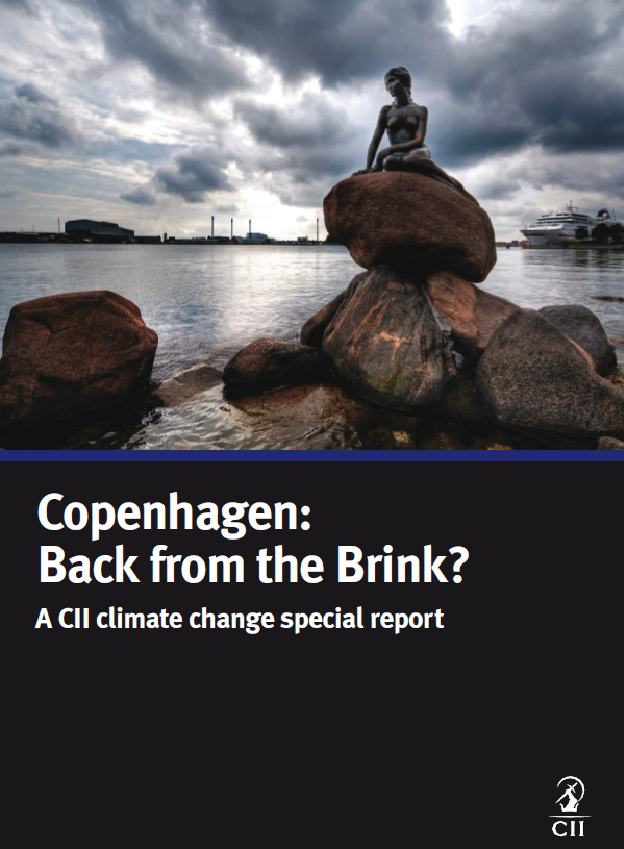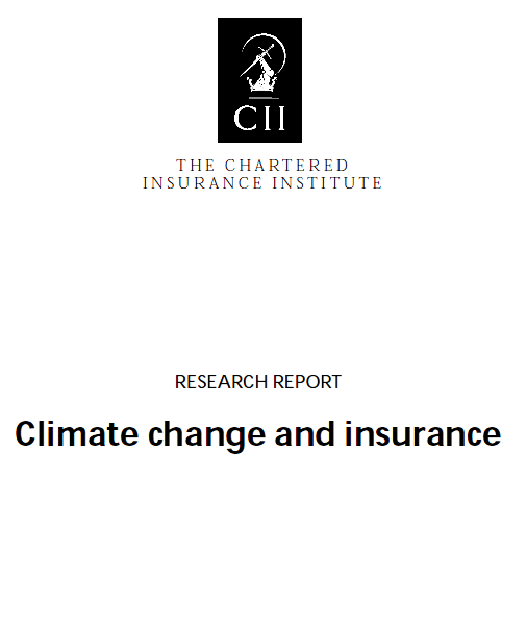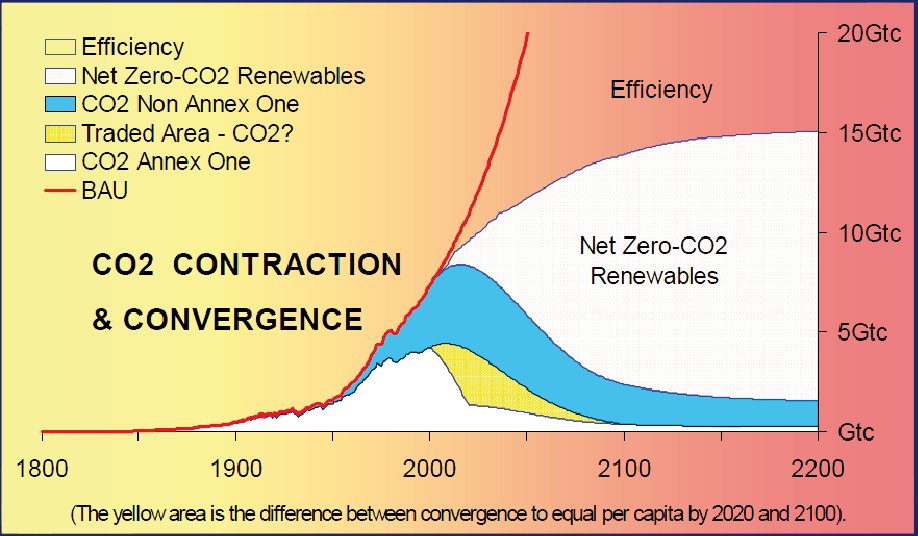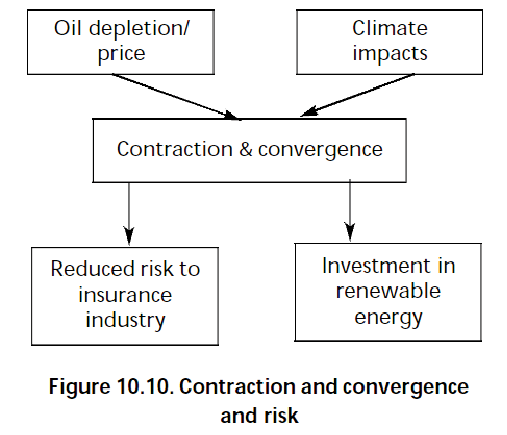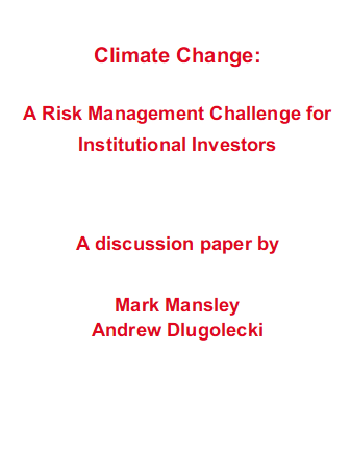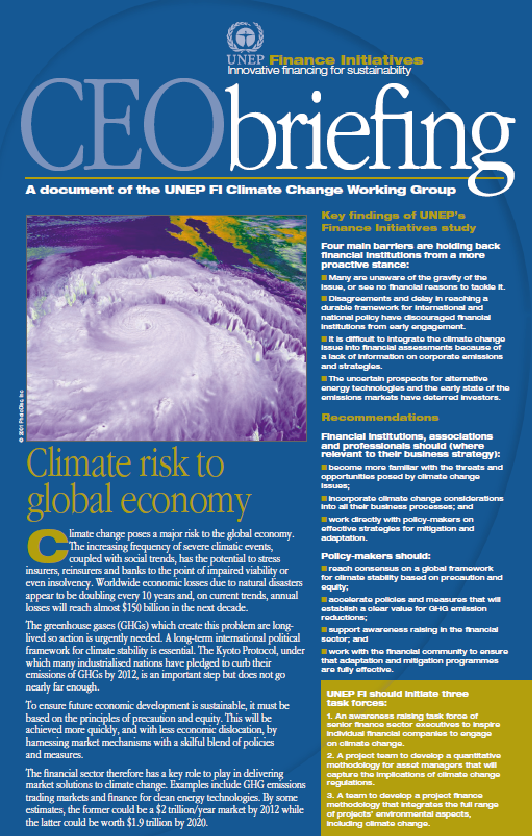Dear Aubrey,
I warmly support and endorse your submission to UNFCCC about Contraction and Convergence.
Regards,
Professor David Crichton,
Fellow of the Chartered Insurance Iinstitute,
Chartered Insurance Practitioner."The potential impact of climate change is immense and it is now widely accepted that time in which to address the problem is running out. Aubrey Meyer and David Crichton look at contraction and convergence as a possible solution."
The authors of the UK Chartered Insurance Institute report on climate change were in no doubt of this when they said in 2001: "The most realistic way to bring about the required reduction in greenhouse gases emissions ... is that proposed in the concept of contraction and convergence."
Far-sighted insurance companies would be well advised to become familiar with this concept, which could have a major impact on their businesses over the next 20 years.
Contraction and convergence is the only solution that is consistent with the principle that is enshrined in the United Nations Charter, which states that everybody is born equal. If you carry this through to its logical conclusion, it means everybody in the world should have equal rights to enjoy the benefits of modern technology. It also means generations still to be born should have equal rights to those living today.
The underlying principle of contraction and convergence is that developing countries should be allowed to grow their emissions while developed countries contract theirs until the figures converge at some agreed per capita level.
This may seem a bit radical to some, but recently, Dr Rowan Williams, the Archbishop of Canterbury, said contract and convergence "appears utopian only if we refuse to contemplate the alternatives honestly".
"Many scientists believe that an atmospheric level of 450 ppmv (parts per million by volume) of carbon dioxide should be the initial target for prudence; already we are at 380. For long-term allocation, the “Contraction and Convergence” model (C&C) seems appropriate. The name C&C reflects the facts that the annual emissions contract to a safe level, and the per capita shares converge to become equal. C&C has the advantages of simplicity and fairness, gives long-term confidence in emissions reduction and in the short-term can accommodate a variety of ‘fixes’ as well as facilitating the flow of funds to developing countries."
"Coping with Climate Change"
CHARTERED INSTITUTE OF INSURERS
The considered the views of some insurance industry experts: -
“Even if we do not know the speed or severity of feedback effects, we must consider the probabilities of disastrous acceleration in climate change within very short time-scales. Risk assessment is the core activity of the insurance industry, the biggest industry in the world. Assessment of risk must fully include feedback effects. Insurers are the leading experts in risk and risk modelling. C&C demonstrates how this can be done. C&C already has a high profile with insurers. Governments need to listen to the insurance industry and make C&C central to government policy around the world. From a risk management point of view, C&C produces an important assessment of the risks we face from human-induced runaway climate change and how to frame a response at the policy level.”
Prof David Crichton- Benfield Hazard Centre UCL“There is a way of cutting global greenhouse gas emissions that is equitable, sensible and workable. It is called Contraction & Convergence, or simply C&C, and it is the brainchild of the South African musician Aubrey Meyer, founder of the London-based Global Commons Institute. Meyer is one of the most extraordinary characters on the climate change activist ‘scene’, who grasped the urgency of finding a viable solution to climate change earlier than most of us realised that there was a problem. Almost two decades ago he gave up a professional music career that included playing with the London Philharmonic Orchestra and writing for the Royal Ballet, to focus on the issue. The C&C concept has been forced onto the world stage by Meyer’s unstinting enthusiasm and incredible work rate. So successful has the lobbying process been that C&C is now a serious contender in terms of forming the basis of the post-Kyoto climate agreement that will, fingers crossed, be signed at Copenhagen in 2009. C&C already has many supporters in government and industry circles around the world. In the months left however, it is imperative that the mechanism is promulgated as widely as possible as the only option available to bring the climate change beast to heel. To help accomplish this, I urge you as strongly as I possibly can to support Aubrey and the GCT, for all our sakes and those of our children and grand children.”
This animation of C&C and risk is brilliant. The Kyoto Protocol is having negligible effect. If successful, Kyoto will result in a slowdown in the rise of global temperatures by 0.02C to 0.28C. That isn’t going to help a great deal and we must decide what comes after Kyoto. It has to have the US, India and China on board. The best hope is a system called contraction and convergence, which works on the premise that everyone on the planet has the right to produce the same amount of greenhouse gas. A level is set for the planet and it is divided by the number of people, so that each country knows how much it can emit per head of population. The overall level is then brought down by agreement.”
Prof Bill McGuire Geophysical & Climate Hazards Director, Aon Benfield UCL Hazard Research Centre
“C&C is so open and transparent. Within the insurance sector it is recognised by CEOs who know they need a long-term global framework within which they can assess their risk. Without C&C they’re stuck with a guesswork approach. A stable insurance industry is essential for a stable economy and a stable financial sector. Insurance needs a long term global framework so it can plan for the future. C&C will help bring this about. It needs to be adopted at the highest level, from the UN down through every business sector.”
“Aubrey Meyer is the most courageous and brilliant climate researcher I have ever met. He is willing to say what other’s merely think. He is quite fearless of any audience and the most eloquent of speaker’s because he knows that ultimately the concept of Contraction and Convergence [C&C] is indestruct-ible and will in the fullness of time be adopted in some form by the UNFCCC. He has developed his arguments over twenty years with a minimum of fund-ing and has refused to compromise his position in any way for financial gain or glory. He is tireless in his research and quest to understand every nu-ance of the climate debate. It has been an honour for me to have known and worked with such a brilliant mind and such an honest person as Aubrey. He has much support from very well placed and respectable people and deserves global recognition for his work. He is quite simply a modern-day genius who will one day be respected for his vision and beliefs. He should be considered for the Nobel Peace prize as his efforts ultimately will save the planet from the ravages of man-induced climate change.”
Dr JULIAN SALT - Director of Climate Solutions
“Aubrey Meyer’s insight into the problem of mitigation of climate change bears the true hallmark of genius: it is simple and robust. His “Contraction & Convergence” model provides a transparent framework that incorporates the clear objective of a safe global level of greenhouse gases, and allocates the responsibility for achieving this internationally with the irresist ible logic of equal shares. At the same time, the model recognises the practical need for an adjustment period to permit nations to conform to the new logic and prepare for a climate-friendly economy. It is no doctrinaire solution, but a brilliantly pragmatic and elegant solution.”
Dr Andrew Dlugolecki - Advisory Board Director, Carbon Disclosure Project
Adviser on Climate Change to UNEP Finance Sector Initiative
Lobby policy makers at the international level through bodies like UNEP Financial Initiative for the adoption of a long-term political framework like Contraction and Convergence.
Weather Catastrophes and Climate Change - Is There Still Hope For Us
Gerhard Berz, Munich Re
“An agreement on global policies to tackle climate change is urgently needed for many reasons. In the first place, evidence is accumulating that the climate system may be more sensitive than we believed even in the recent IPCC report. At the same time, there has not been much progress in putting a systematic halt to emissions, so the problem will get worse. The agreement needs to include credible, strong, phased targets for emissions leading to a global reduction of 50 per cent by 2050; otherwise the price of carbon will be too low to incentivise a change in mindset. The fairest way to share these is the Contraction & Convergence model, which leads to equal emissions percapita in every country."
The industry expert’s view
Dr. Andrew Dlugolecki, FCII, Research Fellow, Climatic Research Unit, University of East Anglia.
Author and editor, Intergovernmental Panel on Climate Change (IPCC)
Contraction & convergence
The most realistic way to bring about the required reduction in ghg emissions (which will have the
combined effect of reducing the damage imposed on the insurance industry and encouraging the transition to renewable energy) is that proposed in the concept of Contraction and Convergence (C&C). This concept was created by the Global Commons Institute (GCI) and is incredibly simple in its detail. Essentially, everyone has the right to emit an equal amount of pollution (in this case CO2) to the Global Commons (atmosphere). At present society emits six billion tonnes of carbon a year (6Gtc) to the atmosphere. Coincidentally there are six billion people alive today hence everyone should be entitled an equal right to emit 1 tonne/yr. To achieve the required global reduction in ghg emissions an agreed target of say 2Gtc by 2040 could be set and the system allowed to contract to that global budget by converging on an agreed per capita allowance. Those states that need to emit more than their share will have to buy emission entitlements from those that have an excess. This would operate in much the same way as the envisaged emissions trading scheme to be set up within the Kyoto Protocol.
Figure 10.9 - The red line shows Business as usual CO2 emissions (BAU). The solid segments show ‘Contraction, Convergence, Allocation and Trade’ to manage emissions down by at least 60% within a given time frame and ‘contraction budget’. The renewables opportunity is worth trillions of dollars the biggest market in history. Annex One is the developed World. Gtc: trillions of tonnes of carbon equivalent.
Figure 10.9 illustrates this process, showing that by the year 2100 emissions will have fallen to well below today’s levels, and will emanate from what are, today, developing countries. Since economic progress is dependent on energy, the shortfall from ‘Business as usual’ energy consumption will need to be met from two directions: efficiency gains, and a rapid growth in renewable energy sources. It is clear from this that emissions trading can only be an intermediate stage, since the total volume of emissions must fall. The only blockage to this simple system is the absence of political will to ‘step outside the box’ instead of conducting a tortuous round of negotiations of the Kyoto Protocol. One way to unblock this impasse is to amass a large enough consensus of stakeholders behind the concept of contraction and convergence, persuading governments to supersede the Kyoto Protocol. The insurance industry is an obvious place to start such a campaign as it has so much to lose and so much to gain. If society continues down the fossil/Kyoto route, future economic losses are likely to become unsustainable: the current rate of increase in damage from natural hazards is 12% pa and the rate is accelerating. Given that the global sum of such losses was $100bn in 1999 (Munich Re, 2000), it would outstrip global GDP (growing at 3% pa) by 2065, if the trends persist. If the insurance industry rallies behind C&C, it not only reduces that risk, but it is well placed to invest in the future renewables market. In fact one could argue that as the insurance companies own the oil companies (through equity ownership), insurers form the only industry that has the collateral and the need to adopt the C&C logic. The desired sequence of events is shown in Figure 10.10.
Climate Change and Insurance
Chartered Institute of Insurers
Beyond Kyoto 'contraction and convergence'
It is important to recognise that any agreement can be only the first step in what will be a major journey. It is clear that even if the Kyoto targets are met, global emissions will continue to rise because of rapidly rising emissions in the developing world. Substantial further steps will have to be taken to curb emissions globally. Such cuts will inevitably begin to involve poor countries and at the same time rich countries are likely to have to commit to much more serious emission reductions themselves. As a result further emission reduction agreements are likely covering the period 2012-20 and beyond. Climate change: a risk management challenge for institutional investors Indeed, the IPCC in its first assessment reports in 1990 recommended emissions cuts of at least 60% to stabilise CO2 concentrations at 1990 levels and thereby be likely to avoid serious climate disruption. Its subsequent reports have not altered this position. In the longer term, ‘Contraction and Convergence’ (C&C) is likely to become increasingly supported as a policy option. C&C was initially advocated by a small UK think tank, the Global Commons Institute39, but has since gained widespread and authoritative support, including that of some poor country governments and also the recent Royal Commission on Environmental Pollution report which recommended that ‘the government should press for a future global climate agreement based on the contraction and convergence approach’. Under C&C, the right to emit greenhouse gases would be apportioned on a per capita basis from a given date. The total amount of emissions would be constrained and would fall steeply until it reached a level considered safe. Since the majority of the world’s population lives in the developing world, while per capita emissions are much higher in the industrialised world, rich countries would need to find ways to reduce their emissions 'contraction' by finding efficiencies or renewable energy sources in the next few decades, or pay handsomely for the privilege of continuing to use fossil fuels. In this way they could approach equal per capita emissions to those in other countries convergence. Ironically, while C&C offers a more robust framework than that outlined by Kyoto and addresses the issue of equity, it also meets the fundamental objection of the US in that it also requires commitments from the developing world. As a global operational framework it also avoids many of the technical problems of Kyoto (such as defining baselines for emissions trading in countries not subject to an overall target, or the extent of international emissions trading that is permissible). However, much will depend on the detail. Done well, C&C could provide a framework for a genuine, equitable, long term solution to climate change, which reduces political risks and provides businesses and investors with the sort of predictable framework they prefer. But if agreement is hard to reach, C&C might serve to highlight injustices and end up exacerbating tensions. For example, some campaigners have argued for a third ‘C’: ‘compensation’ from the rich world for using up the climate’s absorptive capacity. Whilst this claim is understandable, such a development could well become an emotive issue that could make agreement far harder to reach.
Climate Change - A Risk Management Challenge for Insitutional Investors
Mark Mansley and Andrew Dlugolecki
For the long term, the agreement of an international policy based on the principles of precaution,
equity and economic efficiency is critical if we are to reduce the risk and engage all parties in the
endeavour. A number of approaches have been proposed, including the ‘historical’ method, under
which a nation’s future emissions goals would be determined by its past GHG output; the carbon-intensity
approach, in which future emissions goals would be indexed to GDP; and “Contraction and Convergence” which would aim to achieve equal per capita emissions for all nations by an agreed date. Up to now, however, most of the work under the United Nations Framework Convention on Climate Change (UNFCCC) has been directed at finalising and ratifying the Kyoto Protocol.
[For more information on C&C refer to the website of the Global Commons Institute]
UNEPFI CEO Briefing
Back to UNFCCC Submission Back to Signatory List



